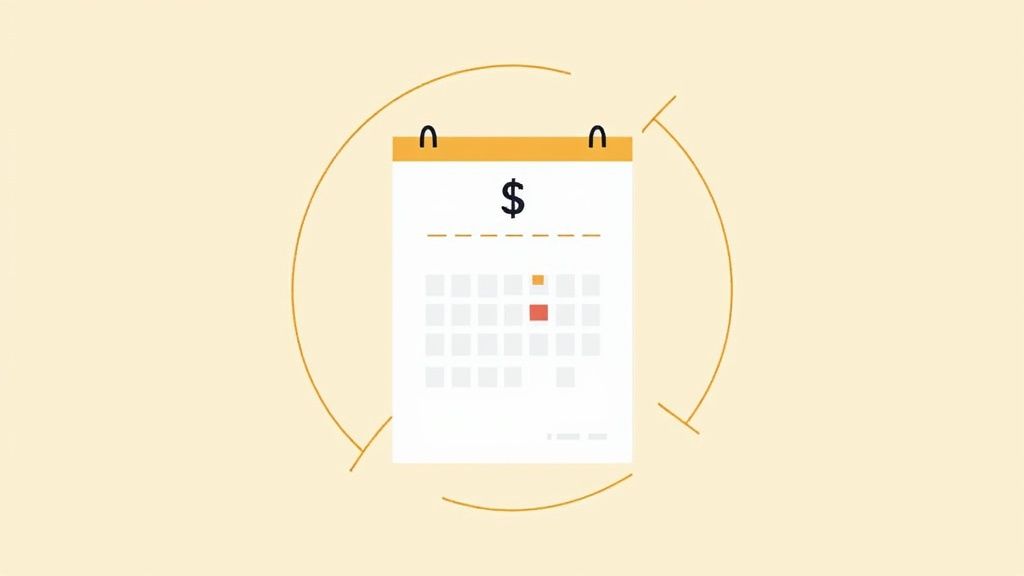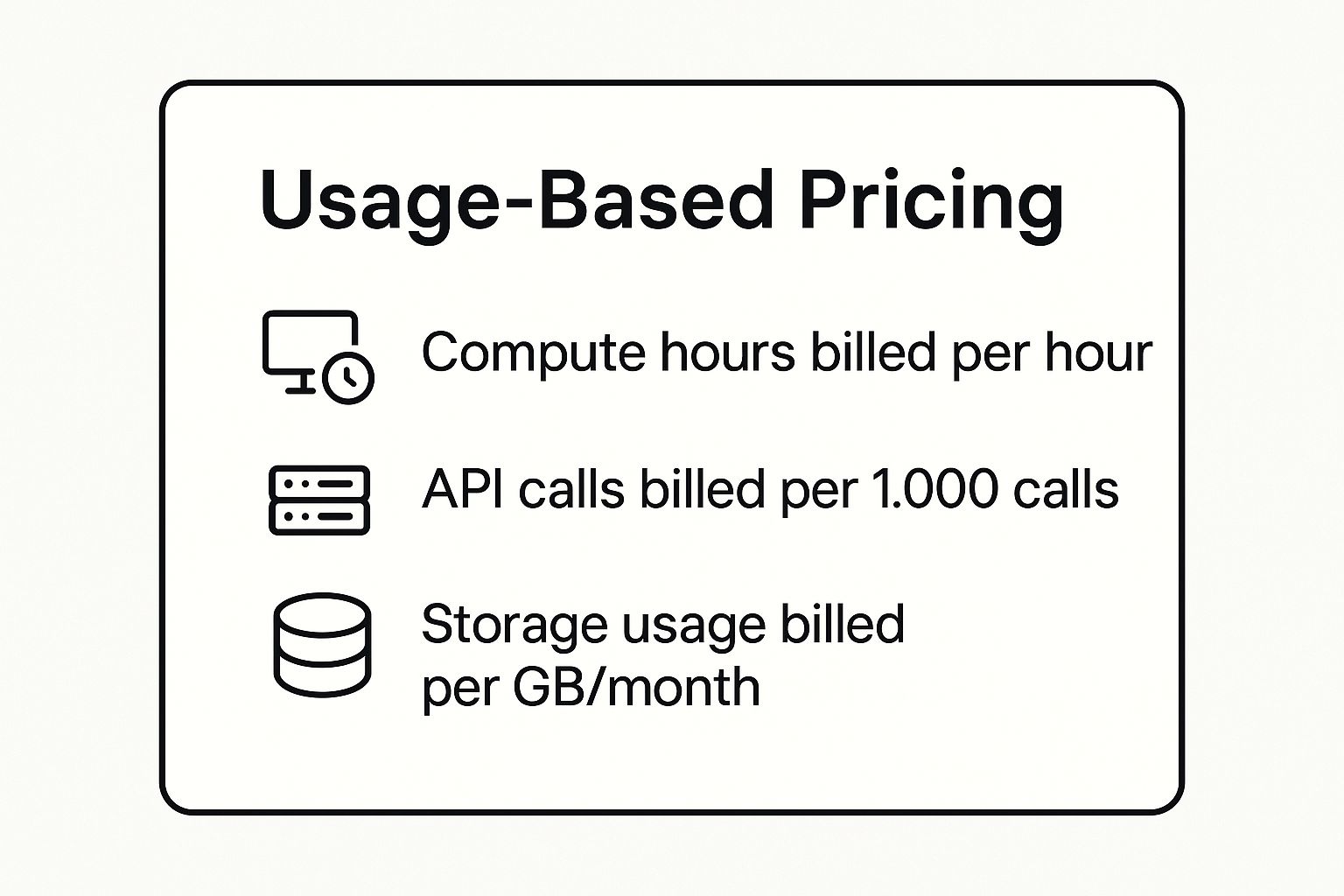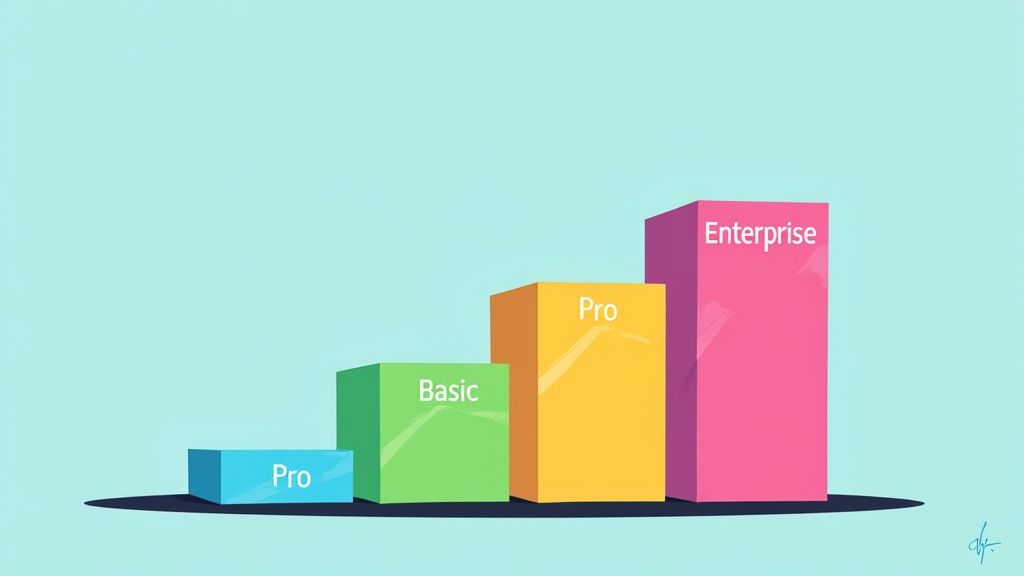6 Sample Pricing Model Breakdowns for SaaS in 2025
Your pricing model is more than just a price tag; it's a fundamental part of your product's strategy that communicates value, targets specific customers, and drives sustainable growth. Choosing the right structure can be the difference between rapid adoption and a constant struggle for traction. Get it right, and you create a powerful engine for acquisition and retention. Get it wrong, and you risk alienating users, undervaluing your service, and leaving significant revenue on the table. This isn't just about what you charge, but how you charge.
This article moves beyond abstract theory to provide a practical breakdown of proven pricing strategies. We will dissect real-world examples from successful SaaS companies, analyzing the mechanics behind their chosen sample pricing model and why it works for them. You won't find generic advice here. Instead, you'll get actionable insights and a clear look at the strategic thinking that powers effective pricing pages.
We will explore six distinct models:
- Freemium
- Subscription
- Usage-Based
- Tiered
- Value-Based
- Penetration
For each model, we'll analyze a specific company's implementation, highlight the core strategy, and provide key takeaways you can apply directly to your own business. Let's dive into the blueprints that build profitable companies.
1. Freemium Pricing Model
The Freemium model is a powerful customer acquisition strategy disguised as a pricing tier. It offers a core, feature-limited version of a product for free, indefinitely, with the goal of converting a fraction of the user base into paying customers for premium features. Unlike a free trial, which is time-bound, the free tier is a permanent offering, designed to lower the barrier to entry and attract a massive top-of-funnel audience.
This approach works by allowing users to experience the product's value firsthand, building trust and integrating it into their workflows. The strategic limitations of the free plan act as gentle, value-driven triggers that encourage users to upgrade when they need more power, capacity, or functionality. It is an excellent sample pricing model for products with low marginal costs and a large potential market.

Strategic Analysis: Slack's Masterclass in Freemium
Slack, the popular communication platform, is a prime example of freemium executed flawlessly. Its free plan is incredibly generous, offering unlimited users and one-on-one video calls. This makes it a no-brainer for small teams and startups to adopt.
However, Slack's genius lies in its single, critical limitation: a 90-day message history. As a team grows and relies more on Slack as its system of record, the inability to access older conversations and files becomes a significant pain point. This limitation doesn't cripple the product's core function but creates a compelling, business-critical reason to upgrade.
Key Takeaway: The best freemium models make the free product genuinely useful but gate access to features that become essential as user engagement and dependency deepen.
Actionable Freemium Tactics
To successfully implement a freemium model, focus on the strategic balance between free value and paid conversion triggers.
- Identify Your Value Metric: What is the core unit of value your users consume? For Dropbox, it's storage space. For Mailchimp, it's contacts. For Slack, it's message history. Build your free tier limits around this metric.
- Design "Upgrade Triggers": Don't just hide features. Create intentional friction points. When a user hits a limit (like Zoom's 40-minute meeting cap), use in-app messaging to clearly explain the benefit of upgrading at that exact moment of need.
- Make the Free Tier a Marketing Engine: A valuable free product encourages word-of-mouth marketing and builds a large user base you can nurture. Ensure it delivers on its core promise to build trust and brand loyalty, making the eventual upsell feel like a natural next step rather than a bait-and-switch.
2. Subscription Pricing Model
The Subscription model is the backbone of the modern SaaS economy, built on recurring revenue. Customers pay a regular fee, typically monthly or annually, for continuous access to a product or service. This approach shifts the focus from a single, transactional sale to a long-term customer relationship, creating predictable revenue streams and fostering loyalty.
Unlike one-time purchases, subscriptions align the company's success with the customer's ongoing satisfaction. This model thrives by delivering consistent value over time, making it a powerful sample pricing model for software, media, content, and even physical goods. It transforms customers from one-off buyers into long-term partners.

Strategic Analysis: Adobe's Pivot to Creative Cloud
Adobe's transition from selling perpetual software licenses (like a $2,500 Creative Suite) to the subscription-based Creative Cloud is a landmark case study. Initially met with user resistance, the move proved to be a strategic masterstroke. It lowered the barrier to entry, making professional-grade tools accessible for a manageable monthly fee instead of a prohibitive upfront cost.
This pivot solved major business challenges. It smoothed out lumpy, launch-dependent revenue cycles into predictable monthly recurring revenue (MRR). It also dramatically reduced piracy and allowed Adobe to deliver continuous updates and new features, keeping the product suite perpetually modern and justifying the ongoing fee. The subscription forced Adobe to focus intensely on customer value and retention.
Key Takeaway: A successful subscription model makes a high-value product more accessible while creating a predictable financial foundation that enables continuous innovation and deeper customer relationships.
Actionable Subscription Tactics
To implement a subscription model effectively, prioritize long-term value and customer health over short-term gains. To understand various approaches and frameworks for this model, consider exploring these proven subscription pricing strategies.
- Incentivize Annual Plans: Offer a significant discount (e.g., two months free) for annual commitments. This boosts cash flow immediately and dramatically improves customer retention by locking them in for a full year.
- Monitor Key Metrics Religiously: Your business now lives and dies by metrics like Monthly Recurring Revenue (MRR), customer churn rate, and Lifetime Value (LTV). A common benchmark is ensuring your LTV is at least 3x your Customer Acquisition Cost (CAC).
- Engineer Clear Upgrade Paths: Design your subscription tiers so that as a customer's needs grow, upgrading to the next plan is a logical and value-driven decision. This is crucial for expanding revenue from your existing customer base.
3. Usage-Based Pricing (Pay-As-You-Go)
The Usage-Based model, also known as pay-as-you-go or metered pricing, directly ties a customer's cost to their consumption. Instead of paying a fixed monthly fee, users are billed based on the amount of a service they use. This model creates a direct and transparent link between the value received and the price paid, removing the barrier to entry for small users while allowing for unlimited revenue scalability.
This approach is highly effective for services where consumption can vary dramatically between customers, such as infrastructure, APIs, and utilities. By aligning cost with value, it minimizes risk for the customer, as they never pay for unused capacity. This makes it an ideal sample pricing model for platforms and services that become deeply integrated into a customer's operations, as revenue naturally grows alongside the customer's success.
The infographic below summarizes common units of value that are metered in usage-based models.

This visualization highlights how different businesses define their core value metric, from processing power to data transactions and storage.
Strategic Analysis: Twilio's API-First Consumption Model
Twilio, the communication platform as a service (CPaaS), is a textbook example of usage-based pricing in action. The company charges developers for each API call, text message sent, or voice minute used. This granular pricing makes it incredibly accessible for a developer to start building with a few dollars, embedding Twilio's functionality into an app without any upfront commitment.
Twilio’s success hinges on this accessibility. A startup can integrate SMS notifications for a tiny cost, but as that startup grows into a massive enterprise like Uber or Airbnb, its Twilio bill scales proportionally into millions of dollars. The pricing model is baked into the customer’s own unit economics, making Twilio an indispensable utility that grows as its customers grow.
Key Takeaway: A powerful usage-based model allows your product to become a utility. By aligning your revenue with your customers' core business metrics, your growth becomes a byproduct of their success.
Actionable Usage-Based Tactics
To implement a successful pay-as-you-go model, focus on transparency, predictability, and alignment with customer value.
- Define a Clear Value Metric: Your billable unit should be simple, predictable, and directly tied to the value your customer receives. Whether it's API calls (Twilio), compute hours (AWS), or transactions (Stripe), it must be easy to understand.
- Prevent "Bill Shock": The biggest risk for customers is an unexpectedly high bill. Mitigate this by providing real-time usage dashboards, spending forecasts, and automated budget alerts. Offering optional spending caps can also build significant trust.
- Consider a Hybrid Approach: Pure usage-based pricing can lead to unpredictable revenue. Consider a hybrid model with a small base subscription fee that includes a starting allowance of usage. This provides a predictable revenue floor while retaining the upside of a consumption model.
4. Tiered Pricing Model
The Tiered Pricing model is a foundational strategy that segments the market by offering multiple packages, each with a distinct set of features and a different price point. This approach is designed to cater to various customer personas, from individuals and small teams to large enterprises, by packaging value into distinct "Good-Better-Best" options. It simplifies the buying process by presenting clear, differentiated choices and creates a natural upgrade path as a customer's needs grow.
This model works by using psychological principles like price anchoring, where a high-priced enterprise tier makes the mid-range option seem more reasonable and valuable. By clearly defining the features and limits of each package, businesses can effectively guide customers to the plan that best suits their needs and budget. This is an essential sample pricing model for SaaS companies aiming to maximize revenue across diverse customer segments.

Strategic Analysis: HubSpot's Growth-Oriented Tiers
HubSpot has perfected the tiered model by aligning its packages directly with customer growth stages. Their products, like the Marketing Hub, are offered in Starter, Professional, and Enterprise tiers. The Starter plan provides essential tools for a small business just beginning its marketing efforts, like forms and email marketing.
The real strategic genius is how the tiers are gated. The Professional tier unlocks critical automation and A/B testing features that become necessary as a business starts to scale its marketing operations. The Enterprise tier adds advanced analytics and partitioning, which are indispensable for large organizations managing multiple teams and brands. This structure transforms HubSpot's pricing from a simple menu into a strategic roadmap for their customers' success, making upgrading a logical step in their growth journey.
Key Takeaway: Effective tiered pricing isn't just about adding more features to higher plans. It's about aligning each tier with a specific customer maturity level and making the next tier the obvious solution to their emerging challenges.
Actionable Tiered Pricing Tactics
To build a successful tiered model, you must carefully engineer the value proposition of each package to guide customer choice.
- Anchor the Choice: Typically design three tiers. The highest-priced tier serves as an "anchor," making the middle tier, your target for most customers, appear as the best-value option. Use visual cues like a "Most Popular" badge to reinforce this choice.
- Differentiate with Value Metrics: Use a combination of feature-gating and usage limits. Lower tiers can be limited by volume (e.g., 1,000 contacts), while higher tiers unlock advanced functionality (e.g., marketing automation). This caters to both usage intensity and need for sophistication.
- Design for the Upgrade: Structure your tiers so that customers naturally outgrow their current plan. Instead of just adding new features to higher tiers, consider what you can strategically remove from lower tiers to create a compelling reason to upgrade as needs evolve. You can find inspiration by reviewing how other companies structure their SaaS pricing page examples.
5. Value-Based Pricing Model
Value-based pricing is a sophisticated strategy that anchors your price to the economic value delivered to the customer, rather than your internal costs or competitor prices. It shifts the conversation from "What does this cost to make?" to "How much is solving this problem worth to my customer?". This model requires a profound understanding of your customer’s pain points, the ROI your product generates, and their willingness to pay for a solution.
This approach allows companies to capture a fair share of the value they create, often resulting in higher margins and stronger market positioning. It is an ideal sample pricing model for B2B SaaS and high-impact products where the benefits, such as increased revenue or reduced costs, can be clearly quantified. It fundamentally aligns your revenue with your customers' success.
Strategic Analysis: Salesforce's Value-Centric Enterprise
Salesforce, a giant in the CRM space, exemplifies value-based pricing at scale. Instead of pricing based on data storage or feature count alone, its tiers are designed around the value delivered to different business segments. The "Sales Cloud" isn't just software; it's a solution priced based on its ability to increase sales team productivity, shorten sales cycles, and boost revenue.
The genius of Salesforce's model is how it quantifies this value. They don't sell features like "workflow automation"; they sell the outcome of "closing more deals, faster." For an enterprise customer, if Salesforce can demonstrably contribute to a 10% increase in revenue, a six-figure subscription fee is no longer an expense but a high-return investment. This reframes the entire purchasing decision around ROI.
Key Takeaway: Effective value-based pricing isn't about what your product is, but what it does for the customer's bottom line. The price should feel like a fraction of the immense value they receive.
Actionable Value-Based Tactics
Implementing a value-based model requires shifting from an internal to an external, customer-centric focus. Successful product management best practices are essential for this transition. For more information, you can explore detailed guides on this topic, like this article that covers key product management best practices.
- Quantify Your Customer's ROI: Don't just claim value, prove it. Conduct customer interviews and case studies to calculate tangible metrics like "time saved," "revenue increased," or "costs reduced." Use this data to build ROI calculators for your sales team.
- Segment by Value Perception: Different customers will derive different levels of value from your product. Segment your audience based on their needs and willingness to pay, creating distinct pricing tiers that align with the specific value each segment receives.
- Train Sales to Sell Value, Not Features: Your sales team is critical. Equip them with the training and materials to lead conversations about business challenges and strategic outcomes, not just product features. Their goal is to anchor the price against the customer's alternative: the high cost of inaction.
6. Penetration Pricing Model
The Penetration Pricing model is an aggressive, short-term strategy focused on market capture rather than immediate profit. It involves launching a product or service at a significantly lower price than the prevailing market rate, sometimes even at a loss. The primary goal is to rapidly attract a large user base, seize market share from established competitors, and create a strong foothold in a new market.
This approach acts as a battering ram to break down entry barriers like brand loyalty and high switching costs. By offering an irresistibly low price, a company can quickly build momentum and user volume. Once a critical mass of customers is achieved and the product becomes entrenched, prices are gradually increased to sustainable, profitable levels. This sample pricing model is most effective for businesses with strong financial backing that can absorb initial losses for long-term strategic gain.
Strategic Analysis: Netflix's Disruption of Home Entertainment
Netflix is a textbook example of penetration pricing used to dismantle an entire industry. When it launched its streaming service, the home entertainment market was dominated by Blockbuster's high-priced, per-rental model. Netflix entered with a simple, low-cost monthly subscription (initially $7.99) for unlimited streaming, a price point that made the value proposition undeniable.
This below-market price made it incredibly easy for consumers to try the service, effectively removing any friction or risk. The low price was not about short-term profit but about rapidly changing consumer behavior and building a massive subscriber base. Once millions of users were hooked on the convenience of streaming and Netflix had secured its market dominance, it could gradually raise prices over the years as it invested in more content, justifying the increase in value.
Key Takeaway: Penetration pricing is most powerful when it not only undercuts competitors on price but also introduces a fundamentally better or more convenient user experience, making it difficult for customers to return to the old model even after prices rise.
Actionable Penetration Tactics
To execute a penetration strategy, you must balance aggressive pricing with a clear path to long-term sustainability.
- Fund the Land Grab: This strategy is capital-intensive. Ensure you have sufficient funding to sustain operations during the initial period of low or negative margins. Your financial model must account for the "burn" required to acquire market share.
- Plan Your Price Escalation: Define the specific milestones or market conditions that will trigger price increases. This could be reaching a certain number of users, achieving a target market share, or rolling out significant feature enhancements. Communicate that the initial price is a limited-time or introductory offer to manage customer expectations.
- Build a Moat: A low price attracts users, but a great product makes them stay. Focus on creating high switching costs through network effects, deep integrations, or unique features. As you grow your user base, leverage tools from your startup marketing stack to nurture loyalty, making it harder for customers to leave when prices eventually normalize. Learn more about the tools that can support your market entry on pages.report.
Sample Pricing Models Comparison
| Pricing Model | Implementation Complexity 🔄 | Resource Requirements ⚡ | Expected Outcomes 📊 | Ideal Use Cases 💡 | Key Advantages ⭐ |
|---|---|---|---|---|---|
| Freemium Pricing Model | Moderate - requires careful tier design and funnels | High - infrastructure and customer support costs | Large user base, low paid conversion (~2-5%), viral growth | SaaS, digital products with low marginal costs, network-effect products | Rapid user acquisition, product demonstration via free tier |
| Subscription Pricing Model | Moderate - needs recurring billing and churn mgmt | Moderate - ongoing updates, customer retention efforts | Predictable recurring revenue, higher LTV, steady cash flow | Products with ongoing value delivery, content platforms, services | Recurring revenue, customer lifetime value, upsell opportunities |
| Usage-Based Pricing Model | High - complex metering/billing infrastructure | High - accurate usage tracking and customer education | Revenue scales with usage, unpredictable forecasting | Cloud services, APIs, infrastructure, variable usage products | Aligns cost with usage, low entry barrier, scalable revenue |
| Tiered Pricing Model | Moderate - requires structured feature segmentation | Moderate - ongoing management of tier value | Segmented customer base, clear upgrade paths | SaaS, B2B services, membership sites with varied customer budgets | Captures different segments, simplifies choice, anchors pricing |
| Value-Based Pricing Model | High - requires deep customer research and pricing expertise | High - ongoing market research and sales training | Higher margins, premium positioning, price aligned with value | B2B products with measurable ROI, professional services, luxury goods | Maximizes profits, differentiates on value, pricing power |
| Penetration Pricing Model | Moderate to high - requires capital and strategic planning | High - sustained losses, marketing and promotion costs | Rapid market share gain, initial low profits, long-term growth | New market entry, platforms with network effects, price sensitive markets | Quick user acquisition, barriers to entry, brand awareness growth |
From Sample to Strategy: Implementing Your Pricing Model
We've journeyed through a diverse landscape of sample pricing model examples, from Slack’s masterful Freemium execution to HubSpot’s value-driven tiers. The key takeaway is clear: pricing is not a static, set-it-and-forget-it decision. It is a dynamic, strategic lever that directly reflects your product's value, targets your ideal customer, and fuels your growth engine. Choosing the right approach is less about finding a perfect template and more about building a framework that can adapt and evolve with your business and the market.
The examples we analyzed demonstrate that the most successful companies treat pricing as an ongoing conversation with their customers. They aren't afraid to blend models, experiment with value metrics, and continuously refine their tiers based on user behavior and feedback. This is the fundamental shift from simply picking a pricing model to building a comprehensive pricing strategy.
Synthesizing Your Strategy: Key Takeaways
Moving from theory to practice requires distilling these examples into actionable principles. As you design or re-evaluate your pricing, keep these core lessons at the forefront:
- Align with Value, Not Just Features: Your pricing should be a direct reflection of the value and outcomes you provide. Instead of just listing features, structure your tiers around the problems you solve for different customer segments. This is the essence of a strong value-based approach.
- Simplicity Sells: Complexity is a major source of friction in the buying process. Whether you choose a tiered, usage-based, or subscription model, ensure potential customers can understand it in seconds. A clear, predictable sample pricing model is your best sales tool.
- Design for Growth: Your pricing structure must create a natural upgrade path. A well-designed Freemium or entry-level tier should actively encourage users to grow into higher-value plans as their needs expand. This "land and expand" motion is critical for long-term revenue growth.
- Data is Your Compass: Don't base your pricing on gut feelings or competitor mimicry alone. Use data from customer interviews, usage analytics, and A/B tests to inform your decisions. Quantify the value your product delivers and price it accordingly.
Your Actionable Next Steps
With these insights in mind, it's time to build. The journey from observing a sample pricing model to implementing your own involves a few critical steps. Start by deeply understanding your customer segments and the unique value you offer each one. Then, map your features to the outcomes they enable, which will help you identify the right value metrics for your model. For a practical look at how these elements come together, you might examine Nuxie's current pricing model to see how they structure their tiers and communicate value.
Finally, remember that your first iteration won't be your last. Launch your pricing, gather feedback, and be prepared to iterate. The most successful pricing strategies are living documents, constantly refined to better serve customers and drive business goals. By adopting this mindset of continuous optimization, you transform pricing from a mere operational task into one of your most powerful strategic advantages, ensuring your business remains competitive and profitable for years to come.
Is your website's performance undermining your pricing strategy? A slow landing page can kill conversions before a customer even sees your pricing. Get a free, in-depth analysis of your site's speed and user experience with Pages.Report. Visit Pages.Report to ensure your technical performance is strong enough to support your business goals.
